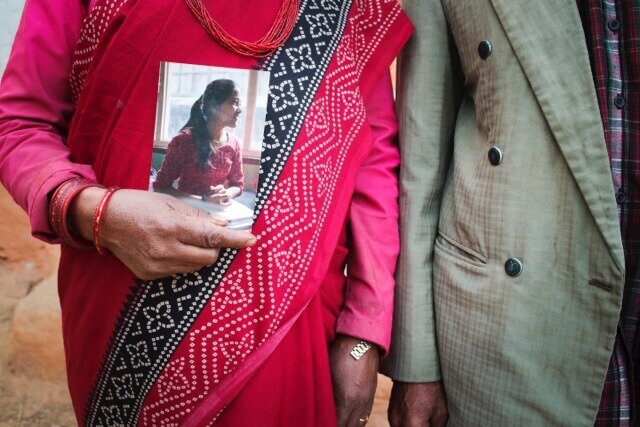
Recently, Mayim moderated a panel for Reel Action: Real Change, an American Jewish World Service event featuring filmmakers whose work exposes human rights abuses. One of those films was “Drawing the Tiger,” a feature-length documentary shot over seven years, and offering a sweeping view of one Nepalese family’s daily struggle to survive off of subsistence farming. Mayim interviewed Amy Benson, the film’s co-director and co-producer.
Mayim Bialik: A lot of our audience is young, interested in artistic expression and in issues that matter. So how did you combine being an artist and dealing with significant issues? How did you become a filmmaker?
Amy Benson: I started making documentaries right when documenting became doable and I fell in love with it. 2001 was a huge year for many reasons. There was 9/11, and suddenly journalism shifted in a major way. Digital media became available to many, many more people; people were just picking up cameras and so when I saw other people picking up cameras and there were digital classes being offered, I just decided to give it a try. I was a teacher and I love teaching, but I just fell in love with documentaries. My husband did as well, so we stopped everything and quit teaching and become filmmakers. It was kind of crazy to quit our nice, decent-paying jobs and careers to try this, but it worked out. I’m so glad we did. Basically, anyone who wanted a documentary, a film, a video of any kind, we just did it for free. We made videos for people who didn’t even want videos.
MB: (Chuckles) How long after starting your documentary career did Drawing the Tiger come about?
AB: We spent three years really learning how to do this documentary thing. We started doing videos for nonprofits. And then this nonprofit out of L.A. commissioned us to make a piece about their organization that provides scholarships for girls to go to school in the Kathmandu region. We were thrilled. So excited. We’d never been to Southeast Asia before and we knew it was going to be like a big life-changing thing, but I had no idea it was going to change our lives in the way that it did.
MB: When you talked about your film at the AJWS event, the story behind the story came out: you were originally setting out to make this film about scholarships and empowering young women of this region of Nepal, and you ended up featuring this one unbelievably exceptional person named Shanta. Can you talk a little bit about what happened that shifted the focus, enabling this to become the documentary that you eventually made?
AB: We met Shanta through the nonprofit and they chose her to be the centerpiece of their promotional video because she was so kick-ass. She came from this tiny village in Central Nepal and she was really, really bright and I just connected with her right away. She had this determination and this incredible spark in her. And when I met her I decided that I wanted to make a film about her to illustrate how educating girls is the best thing that we can do in the world because I saw how much education was changing her life as well as other girls in the organization. And that was before the big girls education movement, or it was right in the beginning, about 2008, when it was really getting out. And I thought, well this is it. This is the answer. We just have to educate all the girls, and Shanta is going to be this role model. And so we made the promotional video for the organization, went back home, cut the video, they put it on their website. About three months later, the executive director for the nonprofit called to say that Shanta had taken her own life. That’s when it all changed. What I believed to be true about how to transform these girls’ lives became very confusing.
It took a long time to figure out what it meant, for me and my husband to figure out what to do, and if we were supposed to do anything. But the nonprofit organization called us shortly after she died to say “Hey, can you take Shanta out of the promotional video? We can’t have her on our website [because of what happened to her.” And it was through the process of literally deleting her that I knew no matter what, I had to do something more about her. I had to figure out why she died. I had wanted to tell her story at the time I met her because she was going to be this role model, at a time when I believed she was going to be. I had no doubt that she was going to make it. And so I thought, why would I tell the story only if she made it?
MB: So you went back to Nepal, correct?
AB: Yes, we went back six times. I went back about three weeks after her death to find out what had happened. I felt desperate to know. With suicide, you never really know. No one can say, this is why she died. And it was at that time that I found out that in Nepal, suicide is the number one cause of death for young girls and women. It was a new statistic that year (2008). So it was because of my need to find out what happened and the fact that Shanta wasn’t the only one. I felt the need to continue her story.
The film took seven years to make. There were about two to three years where I thought I was actually going to know why she died. It took me that long to figure out that we’re never going to know exactly what Shanta was thinking when she was in her apartment and hanging off a rope. But what I could do was figure out what kind of person she was, what led up to it and how it affected her family. And ultimately what I hoped and what I’m hoping the film will do is to show us how complex educating girls actually is. I think that there’s a disconnect between the developing world and the Western world and that we think that if we educate people and that our intention is true and real and we should, then things will be okay. But that is much more complex than we’re believing because we’re complex human beings and Shanta was a very complex human being. And if she had made it, I do believe she would be a huge influencer and a big change for her country. She would have been an activist. She would have been a scholar. Of course I can’t say exactly, but she would have been somebody. [When] girls receive an education, they need more than basic stuff: they need school uniforms, tuition and books. But they also need social and emotional support because they’re often the first people in their family or their village or their community to go to school and they don’t have role models like we do in the States.
MB: Where can people find your film?
AB: Drawing the Tiger is available for educational sale/distribution at http://www.wmm.com/filmcatalog/pages/c945.shtml – here is the link to the trailer: https://vimeo.com/192548987
MB: Thank you so much for speaking with us at GrokNation!
AB: Thank you.




 Read More From Mayim
Read More From Mayim
Grok Nation Comment Policy
We welcome thoughtful, grokky comments—keep your negativity and spam to yourself. Please read our Comment Policy before commenting.